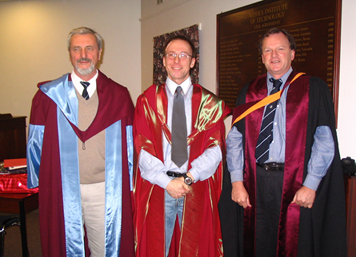Radial Basis Function Spectral Approach For Three-Dimensional Boundary Elements in Elasticity
 Andrea Calaon, Material Engineer graduated at Politecnico di Milano, has recently completed his PhD, entitled “Radial Basis Function Spectral Approach For Three-Dimensional Boundary Elements in Elasticity”. The work was undertaken within the Industrial Divsion at WIT, and was supported by the European LowRiskDT project, investigating the possibility of storing chemically active waste in abandoned underground mines. The external examiner was Dr Stavros Syngellakis from the University of Southampton and the internal examiner was Dr Viktor Popov.
Andrea Calaon, Material Engineer graduated at Politecnico di Milano, has recently completed his PhD, entitled “Radial Basis Function Spectral Approach For Three-Dimensional Boundary Elements in Elasticity”. The work was undertaken within the Industrial Divsion at WIT, and was supported by the European LowRiskDT project, investigating the possibility of storing chemically active waste in abandoned underground mines. The external examiner was Dr Stavros Syngellakis from the University of Southampton and the internal examiner was Dr Viktor Popov.
The investigation work which aimed at reducing the number of degrees of freedom (dofs) in 3D elasticity BEM calculations, led to a new approximation based on Radial Basis Functions, offering spectral convergence. With this method new “semi classical” shape functions extending over many finite elements can be generated. A new super-entity appeared, which has been called Spectral Element (SE). This approach allows also for independence between the description of the geometry and the approximation of the result.
The extended interdependence between the degrees of freedom of the SE and the high continuity of the generated displacements allow for spectral convergence.
Many experiments were carried out, aiming at making the new approach appealing for real engineering cases. The numerical experiments confirmed the property of spectral convergence and an automatic criterion was found and tested, which allows for a maximized Radial Basis Function support.
The SE approximation achieved the same displacement accuracy as classical BEM calculations with a substantially reduced number of dofs, therefore attaining its principal target. Real engineering cases and Hypersingular equations for stress recovery were also tested.
Andrea now works in Italy in the sector of numerical consulting, using BEASY and other engineering software.


 Wessex Institute
Wessex Institute